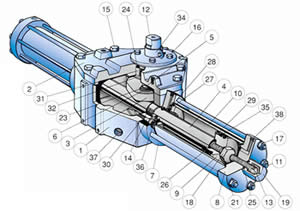Difference between revisions of "Hydraulic Actuators"
| Line 8: | Line 8: | ||
* -------------------------------------------------></noinclude> | * -------------------------------------------------></noinclude> | ||
[[File:Hydraulic actuators.jpg|thumb|right|Hydraulic Actuators]] | |||
'''Hydraulic Actuators''' are mechanical [[Actuators]] that converts hydraulic pressure and flow into torque and angular displacement. The hydraulic actuator is the rotary counter part of the[[Hydraulic Cylinders]]. Conceptually, a hydraulic motor should be interchangeable with a hydraulic pump because it performs the opposite function - much as the conceptual DC electric motor is interchangeable with a DC electrical generator. However, most hydraulic pumps cannot be used as hydraulic actuators because they cannot be | '''Hydraulic Actuators''' are mechanical [[Actuators]] that converts hydraulic pressure and flow into torque and angular displacement. The hydraulic actuator is the rotary counter part of the [[Hydraulic Cylinders]]. Conceptually, a hydraulic motor should be interchangeable with a hydraulic pump because it performs the opposite function - much as the conceptual DC electric motor is interchangeable with a DC electrical generator. However, most hydraulic pumps cannot be used as hydraulic actuators because they cannot be back driven. Also, a hydraulic actuator is usually designed for the working pressure at both sides of the motor.Hydraulic pumps, motors, and cylinders can be combined into hydraulic drive systems. One or more hydraulic pumps, coupled to one or more hydraulic actuators , constitutes a hydraulic transmission. | ||
Hydraulic actuators or hydraulic cylinders typically involve a hollow cylinder having a piston inserted in it. An unbalanced pressure applied to the piston provides force that can move an external object. Since liquids are nearly incompressible, a hydraulic cylinder can provide controlled precise linear displacement of the piston. The displacement is only along the axis of the piston. A familiar example of a manually operated hydraulic actuator is a hydraulic car jack. Typically though, the term hydraulic actuator refers to a device controlled by a hydraulic pump. | Hydraulic actuators or hydraulic cylinders typically involve a hollow cylinder having a piston inserted in it. An unbalanced pressure applied to the piston provides force that can move an external object. Since liquids are nearly incompressible, a hydraulic cylinder can provide controlled precise linear displacement of the piston. The displacement is only along the axis of the piston. A familiar example of a manually operated hydraulic actuator is a hydraulic car jack. Typically though, the term hydraulic actuator refers to a device controlled by a hydraulic pump. | ||
Revision as of 01:00, 5 December 2012
Hydraulic Actuators are mechanical Actuators that converts hydraulic pressure and flow into torque and angular displacement. The hydraulic actuator is the rotary counter part of the Hydraulic Cylinders. Conceptually, a hydraulic motor should be interchangeable with a hydraulic pump because it performs the opposite function - much as the conceptual DC electric motor is interchangeable with a DC electrical generator. However, most hydraulic pumps cannot be used as hydraulic actuators because they cannot be back driven. Also, a hydraulic actuator is usually designed for the working pressure at both sides of the motor.Hydraulic pumps, motors, and cylinders can be combined into hydraulic drive systems. One or more hydraulic pumps, coupled to one or more hydraulic actuators , constitutes a hydraulic transmission.
Hydraulic actuators or hydraulic cylinders typically involve a hollow cylinder having a piston inserted in it. An unbalanced pressure applied to the piston provides force that can move an external object. Since liquids are nearly incompressible, a hydraulic cylinder can provide controlled precise linear displacement of the piston. The displacement is only along the axis of the piston. A familiar example of a manually operated hydraulic actuator is a hydraulic car jack. Typically though, the term hydraulic actuator refers to a device controlled by a hydraulic pump.
